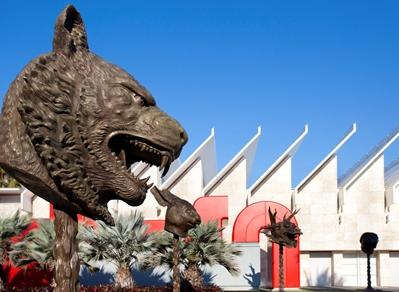In ancient China one’s Zodiac sign was fixed by the position of the planet Jupiter during the year of one’s birth (it takes twelve years for Jupiter to orbit the sun). On this level, Ai Weiwei Circle of Animals/Zodiac Heads represents a system of measuring time and distinguishing characteristics of the human psyche linked to the heavens above.

Ai Weiwei: Circle of Animals/Zodiac Heads, installation view, © Ai Weiwei
In the mid-eighteenth century the Qianlong Emperor, ruler of the Qing (Ch’ing) dynasty—a Manchu (not Chinese) by birth—was fascinated by European technology. On the condition that they not proselytize, he invited European Jesuit priests into the Forbidden City, where they worked as scientists, engineers, architects, and artists. These priests spoke, read, and wrote Chinese fluently; in this way they could easily communicate with the most eminent Chinese and Manchu scholar-officials in the Forbidden City. Sent to China by the Vatican with the mission of converting China to the Catholic Church (in which they largely failed), these priests nonetheless had an enormous influence on Chinese intellectual and artistic life. Among the projects commissioned by the Emperor from the Jesuits was a grand palace known as the Yuan Ming Yuan, or “Palace of Perfect Brightness.” It consisted of a mix of styles: sections built in traditional Chinese wooden architecture and others made of marble, imitating such European palaces as Versailles. In front of one building in the European manner was a large fountain, with twelve animal-headed waterspouts. These functioned as symbols of the Zodiac and of the hours of the day (the Chinese measured the day in units equivalent to two Western hours, which when multiplied by twelve makes up a twenty-four hour day). In an astonishing irony, in 1860 the entire Palace was destroyed and looted by British and French troops as part of military actions of the Second Opium War. Of the twelve original bronze heads, seven survive. In casting his new Zodiac Heads, Ai Weiwei carefully followed the style of the originals, but exercised considerable artistic license in designing the five heads whose models are missing (including the dragon). Ai Weiwei’s Zodiac Heads are thus a multi-layered meditation on political power, the nature of time, and the often tormented relationship between China and West, at the same time calling into question the arbitrary nature of such concepts as “national treasure.” That all of this is accomplished with considerable humor is a tribute to Ai’s detachment. I am proud that LACMA is showing this work by one of China’s greatest artists and most courageous social critics. Stephen Little, curator, Chinese and Korean Art



